
[Source: Nick Catford]
Sudbury Station Gallery 1 1900 - 1959 old37.jpg) Sudbury station seen from the public footbridge to the east of the station before August 1905. In the bottom right corner a siding runs at an angle to a horse dock which is on the site of the
current Sudbury station. The end of a horse box can just be made out. Copyright photo from John Alsop collection 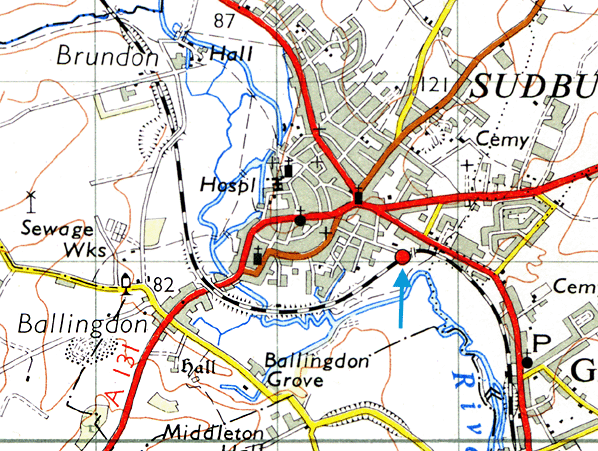 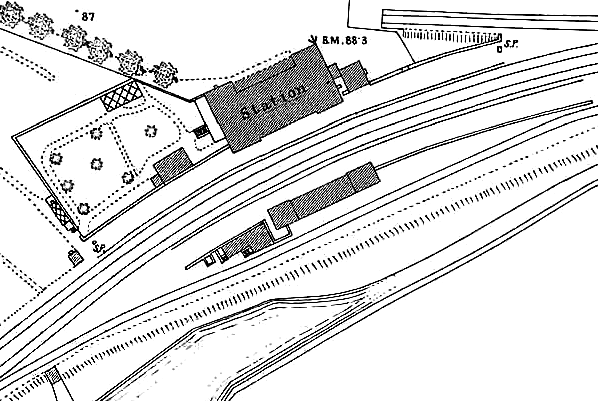
11884 1:500 OS Town Plan shows the layout of the station No canopies or footbridge are shown on this map suggesting they may have been a later addition. The stagger between the two
platforms is clearly seen. 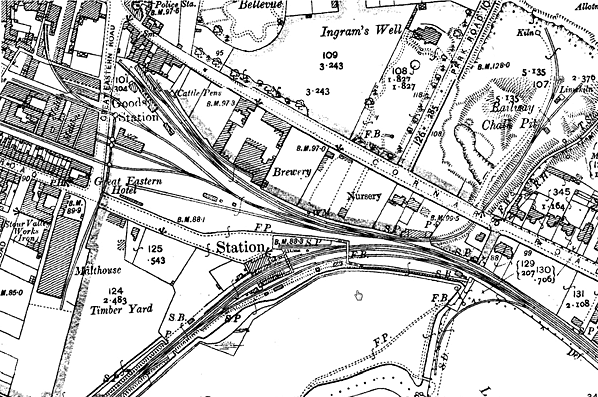
1904 1:2,500 OS map shows the layout of the station. The original terminus is at the top of the map; this became the town's goods station when the line was extended to Cambridge in 1865. The cattle dock and pens are seen opposite the old terminus building. Numerous sidings serve the malthouses on the west side of Great Eastern Road. Each has a small wagon turntable for moving wagons between sidings. A reversal from the line into the goods yard gives access to a short siding serving a railway-owned chalk pit seen top right. An additional goods dock is seen running behind the up platform. Two signal boxes are shown, one at either end of the station. The station box is on the up side to the south-west of the station and the Sudbury Goods box is on the down side to the east of the station. Click here for a larger version of this map.
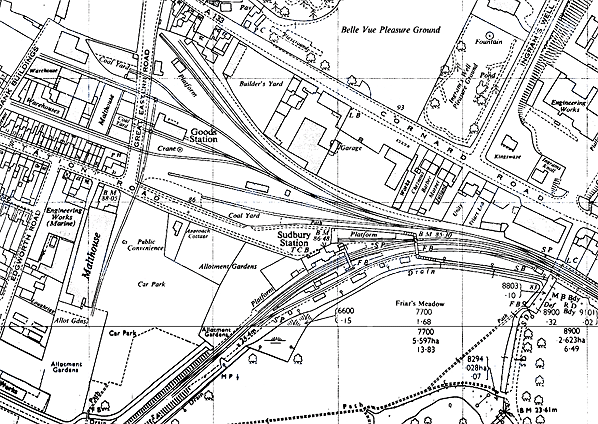 1963 1:2,500 OS map shows little change, either to the station or goods yard. All the sidings serving the malthouses are still in use but the chalk pit and its siding have gone and the pit is occupied by an engineering works. The original station platform is identified on the north side of the yard but the cattle pens opposite appear to have gone. The 5-ton capacity yard crane is identified just south of the main goods shed with the coal yard along the southern boundary of the goods yard. 1963 1:2,500 OS map shows little change, either to the station or goods yard. All the sidings serving the malthouses are still in use but the chalk pit and its siding have gone and the pit is occupied by an engineering works. The original station platform is identified on the north side of the yard but the cattle pens opposite appear to have gone. The 5-ton capacity yard crane is identified just south of the main goods shed with the coal yard along the southern boundary of the goods yard.
old11.jpg)
An early 20th century view of the southern approach to Sudbury station seen from the signal post opposite Sudbury Goods signal box. The original terminus was straight ahead; this was closed in 1865 when the line was extended to Cambridge and a station was opened on the new alignment to the left. At this time the old station was incorporated into the goods yard. The line branching off on the right , which required a reversal from the goods yard , served a railway-owned chalk pit.
Photo from John Mann collection old36.jpg)
A number of carriages are parked on the station forecourt awaiting the arrival of the next train c1910. The boy with the bicycle under the trees on the left side of Station Avenue was H. Ray Hills who became Mayor of Sudbury in 1955.
Copyright photo from John Alsop collection old39.jpg)
Sudbury station forecourt in July 1953. The stationmaster's house is seen on the right. Following closure of the booking office the building was used as the town's museum from 1974 until it was damaged following a break-in and fire in 1985.
Copyright photo from John Alsop collection old38.jpg)
Sudbury station looking east from the down platform in August 1953. The main station building was on the up side and comprised the stationmaster's house, booking office, waiting rooms and toilets. It possessed a plain canopy with a fretted valance stretching the width of the platform
in front of the building. Copyright photo from John Alsop collection old44.jpg) A railbus is seen in the up platform of Sudbury station, probably in the late 1950s. British Railways produced a variety of railbuses as a means both of building new rolling stock cheaply, and providing services economically on lightly-used lines.
Photo from John Mann collection old45.jpg)
A Marks Tey train waits in the up platform at Sudbury station in September 1958. The less substantial down platform building housing waiting rooms and toilets is seen on the right. Note the BR Eastern Region totem signs fixed to the building; being of half-flange design they will have been installed by 1957. Although these signs survived well into the 1960s they had been removed long before corporate identity signage was installed, and not a single Sudbury totem has ever been offered for sale.
old10.jpg)
An eastbound passenger service hauled by 62785 prepares to leave Sudbury station in October 1958. With just 12 months’ service left this Holden-designed E4 was built for the GER at Stratford works in 1895. The 2-4-0 entered GER service as No. 490 in the January and passed into LNER service at the Grouping where it was renumbered 7490. Renumbered to 7802 in November 1942, it was again renumbered by the LNER in 1946 to 2785 and received the 6 prefix at Nationalisation. Withdrawn from 31A, Cambridge shed, during December 1959, this loco has happily been preserved as part of the national collection and is restored to GER livery. It is the only surviving example of this class.
Photo from Jim Lake Collection old48.jpg) An excursion train is seen leaving Sudbury station probably bound for Clacton. The photograph was taken from up in the Sudbury Goods signal box c late1950s. Click here for Sudbury Station Gallery 2 1960 - 2005
 Home
Page Home
Page
|

 The new station was built on a curve with two facing platforms with a slight stagger. The main station building possessed a modest dignity and was a larger version of those found at some intermediate stations on the line beyond to Bury St Edmunds and Cambridge, and on the Braintree – Bishops Stortford line. Located on the up side it comprised a two-storey L-shaped stationmaster's house with a hipped slate roof; this included the booking office and stationmaster's office on the ground floor. The east end of the building was single storey and also 'L' shaped and included waiting rooms and toilets. Both sections of the building were in cream-coloured brick with red brick used for the quoins and the door and window surrounds. The station was sited at the end of a tree lined approach road known as Station Avenue. There was a short canopy above the entrance for the benefit of arriving passengers with a substantial flat timber canopy with a fretted valance stretching the length of the building on the platform side. There was also a W H Smiths bookstall.
The new station was built on a curve with two facing platforms with a slight stagger. The main station building possessed a modest dignity and was a larger version of those found at some intermediate stations on the line beyond to Bury St Edmunds and Cambridge, and on the Braintree – Bishops Stortford line. Located on the up side it comprised a two-storey L-shaped stationmaster's house with a hipped slate roof; this included the booking office and stationmaster's office on the ground floor. The east end of the building was single storey and also 'L' shaped and included waiting rooms and toilets. Both sections of the building were in cream-coloured brick with red brick used for the quoins and the door and window surrounds. The station was sited at the end of a tree lined approach road known as Station Avenue. There was a short canopy above the entrance for the benefit of arriving passengers with a substantial flat timber canopy with a fretted valance stretching the length of the building on the platform side. There was also a W H Smiths bookstall. With the closure of the Cambridge line on 6 March 1967, Sudbury once again became a terminus, and a buffer was placed across the track near the west end of the up platform which was now the only platform in use. Although the bulk of the line between Sudbury and Shelford was lifted in 1970 the track between Sudbury station and the Gasworks Cut (short arm of the River Stour Navigation) remained in place until c1974. When this track was eventually lifted most of it went to the
With the closure of the Cambridge line on 6 March 1967, Sudbury once again became a terminus, and a buffer was placed across the track near the west end of the up platform which was now the only platform in use. Although the bulk of the line between Sudbury and Shelford was lifted in 1970 the track between Sudbury station and the Gasworks Cut (short arm of the River Stour Navigation) remained in place until c1974. When this track was eventually lifted most of it went to the 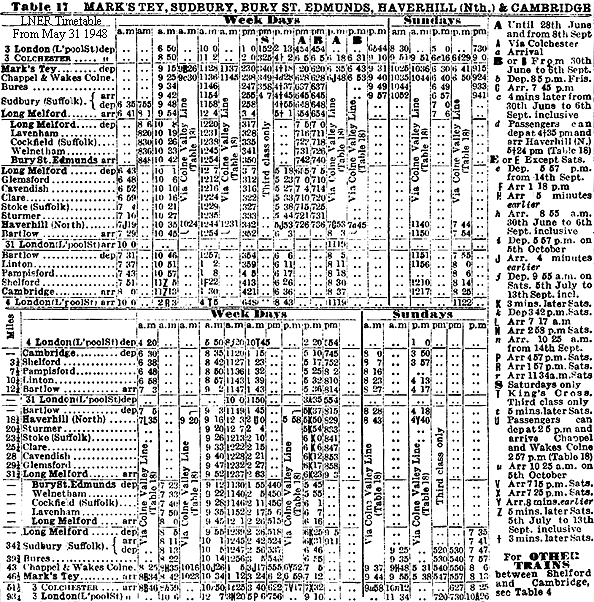
 Sudbury station closed on 28 October 1991 and the station was once again resited to the old dock a short distance to the east to allow redevelopment of the 2nd station site. The station building was quickly demolished and the Kingfisher Leisure Centre was extended onto its site. The third station is still open as the terminus of the
Sudbury station closed on 28 October 1991 and the station was once again resited to the old dock a short distance to the east to allow redevelopment of the 2nd station site. The station building was quickly demolished and the Kingfisher Leisure Centre was extended onto its site. The third station is still open as the terminus of the  The line from Marks Tey to Sudbury opened on 2 July 1849 and on
1 January 1854, the Eastern Counties Railway (ECR) took over the Eastern
Union Railway. In July 1860, the newly formed Sudbury & Clare
Railway Company revived the 1847 Act and by a new Act of July
1860 they were empowered to build a line from Sudbury to Clare
via Melford. However, as soon as the powers were obtained, the
ECR took over and immediately sought extended powers to build
from Sudbury to Shelford on the London-Cambridge main line, plus
a branch from Melford to
The line from Marks Tey to Sudbury opened on 2 July 1849 and on
1 January 1854, the Eastern Counties Railway (ECR) took over the Eastern
Union Railway. In July 1860, the newly formed Sudbury & Clare
Railway Company revived the 1847 Act and by a new Act of July
1860 they were empowered to build a line from Sudbury to Clare
via Melford. However, as soon as the powers were obtained, the
ECR took over and immediately sought extended powers to build
from Sudbury to Shelford on the London-Cambridge main line, plus
a branch from Melford to 
 Closure of the entire line to passengers from Marks Tey to Shelford (Cambridge) was proposed in the Reshaping of British Railways (‘Beeching’) report of March 1963. On 23 April 1965, the British Railways Board gave notice of their intention to close the line from Marks Tey to Cambridge with total closure planned for 31 December 1966. On 19 September 1966 Barbara Castle, the Minister of Transport, agreed to closure from Sudbury to Shelford; however she refused permission to close the Sudbury to Marks Tey section because of commuter needs and planned development at Sudbury, and in the Network for Development map of early 1967 this branch would be shown as part of the basic network to be retained.
Closure of the entire line to passengers from Marks Tey to Shelford (Cambridge) was proposed in the Reshaping of British Railways (‘Beeching’) report of March 1963. On 23 April 1965, the British Railways Board gave notice of their intention to close the line from Marks Tey to Cambridge with total closure planned for 31 December 1966. On 19 September 1966 Barbara Castle, the Minister of Transport, agreed to closure from Sudbury to Shelford; however she refused permission to close the Sudbury to Marks Tey section because of commuter needs and planned development at Sudbury, and in the Network for Development map of early 1967 this branch would be shown as part of the basic network to be retained. The Cambridge to Sudbury Rail Renewal Association was formed
in 1995 to campaign for the restoration of the rail service between
and Sudbury and Cambridge. A full feasibility study was commissioned
in 2003 which showed that 73.2% of people surveyed would use the
railway. It was then decided to form a limited company to present
a more professional approach.
The Cambridge to Sudbury Rail Renewal Association was formed
in 1995 to campaign for the restoration of the rail service between
and Sudbury and Cambridge. A full feasibility study was commissioned
in 2003 which showed that 73.2% of people surveyed would use the
railway. It was then decided to form a limited company to present
a more professional approach.

